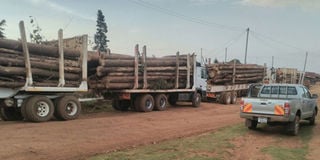Premium
KFS sets rules on logging amid outcry from experts

Trucks belonging to Raiply Wood Company in Timboroa on March 15, 2016.
Kenya Forest Service (KFS) has set conditions for logging in gazetted forests days after President William Ruto lifted a six-year logging ban.
“A detailed harvesting security plan for access, control and monitoring of actual harvesting and reporting has been put in place. As part of the plan, entry certificates will be presented to forest station managers prior to the removal of forest products,” KFS said in a statement.
The agency said it will use harvesting plans to harvest a maximum of 5,000 hectares per year to ensure the government benefits from investments in forest plantations.
The harvested areas will then be replanted as directed by President Ruto.
In addition, KFS said it has already automated the process of issuing plantation harvesting licences, which is done through the district forest conservators.
Payment of taxes has also been automated to ensure compliance with government regulations.
“Upon completion of logging and removal of materials, exit certificates are issued as evidence that all requirements have been met.”
According to the KFS, forest plantations make up six per cent of Kenya’s gazetted forest estate, and the exotic tree species have a rotation period of 25 to 30 years, after which they begin to rot if not harvested.
It said an inventory conducted from 2020 to 2022 revealed a large number of mature and over-mature forest plantations.
Meanwhile, environmentalists have petitioned President Ruto to reconsider his decision to lift the logging ban, warning that the move might derail his efforts to raise Kenya’s tree cover.
Led by Dr Isaac Kalua Green, who is also the founder of the Green Africa Foundation, the environmentalists urged for the full implementation of the 2018 task force report on Forest Resources Management and Logging Activities in Kenya before lifting of the ban is implemented.
Tree planting campaign
President Ruto launched a nationwide tree planting campaign in December last year to raise Kenya’s tree cover to 30 per cent by 2032, but this week announced the government’s decision to lift the ban on logging.
President Ruto, who was speaking at St Mary’s Catholic Church in Molo, Nakuru County, said the government has put in place plans to ensure that only mature trees are harvested while more are planted.
But yesterday, Dr Kalua said lifting the ban will only derail efforts to increase the country’s forest cover.
“I appeal to H.E the President of Kenya to kindly reconsider this move based specifically on scientific processes, the importance of the people of this country, understanding and appreciating that the forest is all we have,” Dr Kalua said.
He pointed out that prior to 2018, illegal logging activities were rampant in public forests, which contributed negatively to the state of local rivers, water availability and even food security.
“Rains had failed for three consecutive seasons. Consequently, the government decided to take decisive action and on February 24, 2018, then Deputy-President William Ruto declared a three-month moratorium on timber harvesting. Two days later, on February 26, a task force for reviewing forestry management was gazetted. I was part of this task force because I was serving as chairperson of the Kenya Water Towers Agency at the time,” Dr Kalua said.
He went on: “Then Deputy President William Ruto launched the task force on March 5, 2018. When we concluded our work and presented our task force report to him one month later, he embraced it fully and committed to implement our recommendations.”
Dr Kalua noted that nothing has changed since 2018 to warrant lifting on the ban on logging.
“We still face erratic rainfall and unlike 2018 when rains had failed for three consecutive seasons, we have experienced five consecutive failed rain seasons. This means that on the rain front, things are worse, not better. We, therefore, need more fully grown trees, not less,” said Dr Kalua, who is also the party leader of Green Thinking Action Party.
Forest cover
“In Kenya, we lose 50,000 hectares of forest cover per year and replace that with less than that amount. Our annual per capita usage of timber is one cubic meter per person, which is an equivalent of three trees. In other words, on average, every Kenyan uses three fully grown 10-15-year-old trees every year, through various ways that include charcoal and furniture. Cumulatively, we cut and use at least 150 million trees yet produce far less than that every year,” he said.
To achieve one per cent forest cover, he said, there is need to plant 580 million trees. “The above figures make it clear that we simply cannot afford to cut down fully grown trees with the express purpose of extracting timber from them,” he said.
However, the lifting of the ban has been welcomed by farmers who have invested in commercial forestry in the North Rift.
The farmers, who have mainly invested in fast-maturing eucalyptus trees, said the move will boost trade in tree products.
“The country lost billions in revenue while thousands of workers were laid off, resulting in increased poverty levels,” said Mr Jackson Kipkosgei from Kaptagat, Elgeyo-Marakwet County.
The ban affected giant sawmills such as Raiply Woods in Eldoret, which employs thousands of workers. “Most of the sawmillers lost their assets, including machinery, to service loans they had taken from financial institutions to keep their businesses afloat,” said Mr Joshua Too of Kimondi, Nandi County.
Reporting by Justus Ochieng, Kevin Cheruiyot and Barnabas Bii





